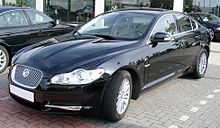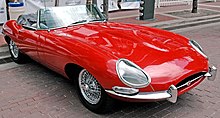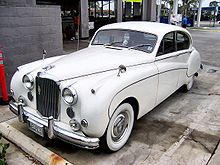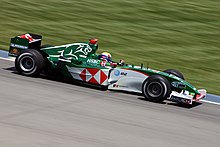Jaguar Cars Ltd, known simply as Jaguar , is a British luxury and sports car manufacturer, headquartered in Whitley, Coventry, England. It is part of the Jaguar Land Rover business, a subsidiary of the Indian company Tata Motors.
Jaguar was founded as the Swallow Sidecar Company by Sir William Lyons in 1922, originally making motorcycle sidecars before developing passenger cars. The name was changed to Jaguar after WWII to avoid the unfavourable connotations of the SS initials. Following a merger with the British Motor Corporation in 1968, subsequently subsumed by Leyland, which itself was later nationalised as British Leyland, Jaguar was listed on the London Stock Exchange in 1984, and became a constituent of the FTSE 100 Index until it was acquired by Ford in 1990. Jaguar has, in recent years, manufactured cars for the Prime Minister, the most recent delivery being a XJ model on 11 May 2010. The company also holds royal warrants from HM Queen Elizabeth II and HRH Prince Charles.
Jaguar cars today are designed in Jaguar Land Rover's engineering centres at the Whitley plant in Coventry and at their Gaydon site in Warwickshire, and are manufactured in Jaguar's Castle Bromwich assembly plant near Birmingham.
Birth of the company
Cash was short after World War II, and Jaguar sold the plant and premises of Motor Panels, a pressed steel body manufacturing company they had acquired in the late 1930s when growth prospects seemed more secure. The buyer was Rubery Owen.[8] Nevertheless, Jaguar achieved relative commercial success with their early post war models; times were also tough for other Coventry-based auto-makers and the company was able to buy from John Black's Standard Motor Company the plant where Standard had built the six-cylinder engines it had been supplying to Jaguar.
Jaguar's sales slogan for years was "Grace, Space, Pace",[citation needed] a mantra epitomised by the record sales achieved by the MK VII, IX, Mks I and II saloons and later the XJ6.
The core of Bill Lyons' success following WWII was the Twin Cam Straight Six Cylinder Engine—a design conceived pre-War and realised while design staff at the Coventry plant were dividing their time between fire-watching (Coventry being a prime Luftwaffe target) and designing the new power plant.
To place this in context, benchmark for pre-war racing and competition engines was the "Double Knocker", or Twin Cam engine. Jaguar's new engine was a hemispherical cross-flow cylinder head with valves inclined from the vertical; originally at 30 degrees (inlet) and 45 degrees (exhaust) and later standardised to 45 degrees for both inlet and exhaust.
As fuel octane ratings were relatively low from 1948 onwards, three piston configuration were offered: Domed (High Octane), Flat (Medium Octane), and Dished (Low Octane).
The main designer, William "Bill" Heynes, assisted by Walter "Wally" Hassan, was determined to design the Twin OHC unit. Bill Lyons agreed over misgivings from Hassan. It was risky to take what had previously been considered a racing or low-volume and cantankerous engine needing constant fettling and applying it to reasonable volume production saloon cars.
The subsequent engine (in various versions) was the mainstay powerplant of Jaguar, used in the XK 120, Mk VII Saloon, Mk I and II Saloons and XK 140 and 150. It was also employed in the E Type, itself a development from the race winning and Le Mans conquering C and D Type Sports Racing cars refined as the short-lived XKSS, a road-legal D Type.
Few engine types have demonstrated such ubiquity and longevity: Jaguar used the Twin OHC XK Engine, as it came to be known, in the Jaguar XJ6 saloon from 1969 through 1992, and employed in a J60 variant as the power plant in such diverse vehicles as the British Army's Scorpion Light Armoured Combat Reconnaissance Vehicle and its several variants, as well as the Fox Milan reconnaissance and Fox Scout armoured vehicles, the Ferret Scout Car, and the Stonefield four-wheel-drive all-terrain lorry. Properly maintained, the standard production XK Engine would achieve 200,000 miles of useful life.
Two of the proudest moments in Jaguar's long history in motor sport involved winning the Le Mans 24 hours race, firstly in 1951 and again in 1953. The 1955 victory was somewhat overshadowed by the tragic events that occurred. Later in the hands of the Scottish racing team Ecurie Ecosse two more wins were added in 1956 and 1957.
In spite of such a performance orientation, it was always Lyons' intention to build the business by producing world-class sporting saloons in larger numbers than the sports car market could support. Jaguar secured financial stability and a reputation for excellence with a series of elegantly styled luxury saloons that included the 3 & 3½ litre cars, the Mark VII, VIII, and IX, the compact Mark I and 2, and the XJ6 and XJ12. All were deemed very good values, with comfortable rides, good handling, high performance, and great style.
Combined with the trend-setting XK 120, XK 140, and XK 150 series of sports car, and nonpareil E-Type,[citation needed] Jaguar's elan as a prestige motorcar manufacturer had few rivals. The company's post-War achievements are remarkable, considering both the shortages that rove Britain (the Ministry of Supply still allocated raw materials) and the state of metallurgical development of the era.
In 1951, Jaguar leased Browns Lane from The Daimler Motor Company Limited, which quickly became its principal plant. Jaguar purchased Daimler—not to be confused with Daimler-Benz or Daimler AG—in 1960 from the holding company BSA. From the late 1960s, Jaguar used the Daimler marque as a brand name for their most luxurious saloons.
British Leyland
Jaguar merged with the British Motor Corporation (BMC), the Austin-Morris combine, to form British Motor Holdings (BMH) in 1966. After merging with Leyland, which had already taken over Rover and Standard Triumph, the resultant company then became the British Leyland Motor Corporation (BLMC) in 1968. Financial difficulties and the publication of the Ryder Report led to effective nationalisation in 1975 and the company became British Leyland, Ltd (later simply BL plc).In the 1970s, the Jaguar and Daimler marques formed part of BL's specialist car division or Jaguar Rover Triumph Ltd until a restructure in the early 1980s saw most of the BL volume car manufacturing side becoming the Austin Rover Group, which didn't include Jaguar. In 1984, Jaguar was floated off as a separate company on the stock market – one of the Thatcher government's many privatisations.
Ford Motor Company era
Under Ford's ownership Jaguar expanded its range of products with the launch of the S-Type in 1999 and X-type in 2001. Since Land Rover's May 2000 purchase by Ford, it has been closely associated with Jaguar. In many countries they share a common sales and distribution network (including shared dealerships), and some models now share components, although the only shared production facility was Halewood, for the X-Type and the Freelander 2. However operationally the two companies were effectively integrated under a common management structure within Ford's PAG.
On 11 June 2007, Ford announced that it planned to sell Jaguar, along with Land Rover and retained the services of Goldman Sachs, Morgan Stanley and HSBC to advise it on the deal. The sale was initially expected to be announced by September 2007, but was delayed until March 2008. Private equity firms such as Alchemy Partners of the UK, TPG Capital, Ripplewood Holdings (which hired former Ford Europe executive Sir Nick Scheele to head its bid), Cerberus Capital Management and One Equity Partners (owned by JP Morgan Chase and managed by former Ford executive Jacques Nasser) of the US, Tata Motors of India and a consortium comprising Mahindra and Mahindra (an auto manufacturer from India) and Apollo Management all initially expressed interest in purchasing the marques from the Ford Motor Company.
Before the sale was announced, Anthony Bamford, chairman of British excavator manufacturer JCB had expressed interest in purchasing the company in August 2006, but backed out upon learning that the sale would also involve Land Rover, which he did not wish to buy. On Christmas Eve of 2007, Mahindra and Mahindra backed out of the race for both brands, citing complexities in the deal.
Tata Motors era
On 1 January 2008, Ford formally declared that Tata was the preferred bidder. Tata Motors also received endorsements from the Transport And General Worker's Union (TGWU)-Amicus combine as well as from Ford. According to the rules of the auction process, this announcement would not automatically disqualify any other potential suitor. However, Ford (as well as representatives of Unite) would now be able to enter into detailed discussions with Tata concerning issues ranging from labour concerns (job security and pensions), technology (IT systems and engine production) and intellectual property, as well as the final sale price. Ford would also open its books for a more comprehensive due diligence by Tata. On 18 March 2008, Reuters reported that American bankers Citigroup and JP Morgan would finance the deal with a USD 3 billion loan.On 26 March 2008, Ford announced that it had agreed to sell its Jaguar and Land Rover operations to Tata Motors of India, and that they expected to complete the sale by the end of the second quarter of 2008.Included in the deal were the rights to three other British brands, Jaguar's own Daimler, as well as two dormant brands Lanchester and Rover.] On 2 June 2008, the sale to Tata was completed at a cost of £1.7 billion.
Assembly plant
The Swallow Sidecar company (SSC) was originally located in Blackpool but moved to Holbrook Lane, Coventry in 1928 when demand for the Austin Swallow became too great for the factory's capacity.[30] In 1951, having outgrown the original Coventry site they moved to Browns Lane, which had been a wartime "shadow factory" run by the Daimler Motor Company. Today, Jaguars are assembled at Castle Bromwich in Birmingham and Halewood in Liverpool. The historic Browns Lane plant ceased trim and final operations in 2005, the X350 XJ having already moved to Castle Bromwich two years prior, leaving the XK and S-Type production to Castle Bromwich and the X-Type at Halewood, alongside the new Land Rover Freelander 2, from 2007. A reduced Browns Lane site operates today, producing veneers for Jaguar Land Rover and others, as well as some engineering facilities.
Current car models
XF
The Jaguar XF is a mid-size executive car introduced in 2008 to replace the out-going S-Type. In January 2008, the XF was awarded the What Car? 'Car of the Year' and 'Executive Car of the Year' awards. The XF was also awarded Car of the Year 2008 from What Diesel? magazine. Engines available in the XF are a 3.0-litre V6 diesel or petrol and a 5.0-litre V8 supercharged called the XFR, or naturally aspirated V8 petrol, and—in the US—a 5.0-litre V8, introduced in 2010. From 2011, the 2.2 L diesel engine from the Land Rover Freelander was added to the range as part of a facelift.
XK
The Jaguar XK is a luxury grand tourer introduced in 2006, where it replaced the Jaguar XK8. The XK introduced an aluminium monocoque bodyshell, and is available both as a two-door coupé and two-door cabriolet/convertible.
XJ
The Jaguar XJ is a full-size luxury saloon and the company's flagship model. The model has been in production since 1968 with the first generation being the last Jaguar car to have creative input by the company's founder, Sir William Lyons. In early 2003, the third generation XJ arrived in showrooms and while the car's exterior and interior styling were traditional in appearance, the car was completely re-engineered. Its styling attracted much criticism from many motoring journalists who claimed that the car looked old-fashioned and barely more modern than its predecessor, many even citing that the 'Lyons line' had been lost in the translation from Mark 2 into Mark 3 XJ, even though beneath the shell lay a highly advanced aluminium construction that put the XJ very near the top of its class.
Jaguar responded to the criticism with the introduction of the fourth generation XJ, launched in 2009. Its exterior styling is a departure from previous XJs, with a more youthful, contemporary stance, following the design shift that came into effect previously with the company's XF and XK models.
The 5-litre V8 engine in the XJ Supersport can accelerate the car from 0–60 mph (0–97 km/h) in 4.7 seconds, and has a UK CO2 emission rating of 289 g/km. To cater to the limousine market, all XJ models are offered with a longer wheelbase (LWB) as an option, which increases the rear legroom.
Previous models
Recent
The Jaguar S-Type, first appeared in 1999 and stopped production in 2008. It has now been replaced by the Jaguar XF. Early S-Types suffered from reliability problems but those were mostly resolved by the 2004 model year.
The Jaguar X-Type was a compact executive car launched in 2001, while the company was under Ford ownership. Sharing its platform with a 2000 Ford Mondeo, the X-Type lasted just one generation. The model ceased production in 2009.
Historic
The Jaguar company started production with the pre-war 1.5, 2.5 and 3.5-litre models, which used engines designed by the Standard Motor Company. The 1.5-litre four-cylinder engine was still supplied by Standard but the two larger six-cylinder ones were made in house. These cars have become known unofficially as Mark IVs.
The first post-war model was the 1948 Mark V available with either 2.5- or 3.5-litre engines, and it had a more streamlined appearance than pre-war models, but more important was the change to independent front suspension and hydraulic brakes.
The big breakthrough was the launch in 1948 of the XK120 sports car, powered with the new XK twin overhead camshaft (DOHC) 3.5-litre hemi-head six-cylinder engine designed by William Heynes, Walter Hassan and Claude Baily. This engine had been designed at night during the war when they would be on fire watch in the factory. After several attempts a final design was achieved. That is until owner William Lyons said "make it quieter". The car had originally been intended as a short production model of about 200 vehicles as a test bed for the new engine until its intended home, the new Mark VII saloon, was ready. The XK120's exceptional reception was followed in 1954 by the introduction of the derivative XK140, and a much revised XK150.
Jaguar launched E-Type in 1961. Along with sports cars, Jaguar maintained a strong place in the upscale saloon car market. Introducing the large Mark VII in 1951, a car especially conceived for the American market, Jaguar was overwhelmed with orders. The Mark VII and its successors gathered rave reviews from magazines such as Road & Track and The Motor. In 1956 a Mark VII won the prestigious Monte Carlo Rally.
In 1955, the "2.4-Litre" saloon (subsequently known as the 2.4 Mark 1) was the first monocoque (unitary) car from Jaguar.[citation needed] Its 2.4-litre short-stroke version of the XK engine provided 100 miles per hour (160 km/h) performance. In 1957, the 3.4-litre version with disk brakes, wire wheels and other options was introduced, with a top speed of 120 mph (190 km/h). In 1959, an extensively revised version of the car with wider windows and 2.4, 3.4, and 3.8-litre engine options became the Mark 2. The 3.8 Mark 2 was popular with British police forces for its small size and 125 mph (201 km/h) performance.
The Mark VIII of 1956 and Mark IX of 1958 were essentially updates of the Mark VII, but the Mark X of 1961 was a completely new design of large saloon with all round independent suspension and unitary construction.
The independent rear suspension from the Mark X was incorporated in the 1963 S-Type, which closely resembled the Mark 2, and in 1967 the Mark 2 name was dropped when the small saloon became the 240/340 range. The 420 of 1966, also sold as the Daimler Sovereign, put a new front onto the S-type, although both cars continued in parallel until the S-Type was dropped in 1968. The Mark X became the 420G in 1966.
Of the more recent saloons, the most significant is the XJ (1968–1992), still the definitive Jaguar saloon car for many.[who?] From 1968 on, the Series I XJ saw minor changes, first in 1973 (to Series II), 1979 (Series III), a complete redesign for 1986/1987 in XJ40, further modifications in 1995 (X300), in 1997 with V8-power (X308), and a major advance in 2003 with an industry-first aluminium monocoque-chassis (X350). The most luxurious XJ models carried either the Vanden Plas (US) or Daimler (rest of world) nameplates. In 1972 the 12-cylinder engine was introduced in the XJ, while simultaneously being offered in the E Type.
1992 saw the introduction of the mid-engined, twin-turbo XJ220. Designed to compete head-on with the Ferrari F40 and Porsche 959 supercars,[citation needed] the XJ 220 was powered by a 542 bhp (404 kW; 550 PS) V6 engine. The XJ220 was confirmed the fastest production car in the world at the time after Martin Brundle recorded a speed of 217 mph (349 km/h) on the Nardo track in Italy.
Complete line-up
[edit] Large executive
- 1935–1948 2½ Litre saloon
- 1937–1948 3½ Litre saloon
- 1948–1951 Mark V
- 1951–1957 Mark VII (& VIIM)
- 1957–1959 Mark VIII
- 1959–1961 Mark IX
- 1961–1966 Mark X
- 1966–1970 420G
- 1968–1987 XJ6 Series 1, 2 & 3
- 1972–1992 XJ12
- 1986–1994 XJ6 (XJ40)
- 1993–1994 XJ12 (XJ81)
- 1995–1997 XJ6 & XJ12 (X300 & X301)
- 1998–2003 XJ8 (X308)
- 2004–2009 XJ (X350)
- 2009–date XJ (X351)
[edit] Compact executive
[edit] Sports
- 1948–1954 XK120
- 1954–1957 XK140
- 1957–1961 XK150
- 1961–1974 E-Type
- 1975–1996 XJ-S
- 1992–1994 XJ220
- 1996–2003 Jaguar XK8 [39]
- 1997–2005 XKR (X100)
- 2007–present XKR (X150)
[edit] Racing and competition
- 1950s C-Type
- 1950s D-Type
- 1960s E-Type Lightweight
- 1985–1992 XJR-5 through XJR-17
- 2009 Bonneville 225.675 mph (363.189 km/h) XFR
- 2010 Jaguar XKR GT2 RSR
Concept models
- E1A—The 1950s E-Type concept vehicle
- E2A—The Second E-Type concept vehicle, which raced at LeMans and in the USA
- Pirana (1967)
- XJ13 (1966)—Built to race at LeMans, never run
- XK180 (1998)
- F-Type (2000)—Roadster, similar to the XK8 but smaller
- R-Coupé (2002)—Luxury four-seater coupé
- Fuore XF 10 (2003)
- R-D6 (2003)—Compact four-seat coupé
- XK-RR—A high-performance version of last generation XK coupé
- XK-RS—Another performance-spec version of last generation XK convertible
- Concept Eight (2004)—Super-luxury version of the long-wheelbase model of the XJ
- C-XF (2007)
- Jaguar C-X75 (2010)
- Jaguar C-X16 (September 2011)
Engines
Jaguar has designed in-house four generations of engines.
- Historical engines:
- Current engines:
R models
Jaguar began producing R models in 1995 with the introduction of the first XJR. Powered by a supercharged 6-cylinder engine, the car produced approximately 322 horsepower. With the revamped line of engines, the powerplant would be based on an eight-cylinder engine with supercharger from 1997 to present. The 1997–2003 XJR produced 370 horsepower (276 kW) and 385 pound-feet (522 N·m) of torque, taking the car to 60 mph (97 km/h) in just under 5.3 seconds. The new aluminium bodyshell from 2004 to 2009 and increased power to 400 hp (298 kW) and enhanced computer systems decreased the time to 60 mph (97 km/h) to a little over 5 seconds. Starting after year 2000, XJRs were equipped with Jaguar's CATS (Computer Active Technology Suspension), which helped firm up the ride in sporty driving without compromising comfort during day-to-day use.
The first XKR was introduced in 1997 and kept with the same power increases as the XJR except for after 2006 the power in the XKR was boosted to 420 hp (313 kW). The S-Type R had a short production run from 2003 to 2008, and came equipped with the same 400 horsepower (298 kW) supercharged V8 as the other R models. It was replaced by the XFR, featuring a 5.0 L supercharged V8 producing 510 hp (380 kW).
- Jaguar XFR—mid-size saloon
- Jaguar XJR—full-size saloon
- Jaguar XKR—coupé and cabriolet
Motorsport
The company has had major success in sports car racing, particularly in the Le Mans 24 Hours. Victories came in 1951 and 1953 with the C-Type, then in 1955, 1956 and 1957 with the D-Type. The manager of the racing team during this period, Lofty England, later became CEO of Jaguar in the early 1970s. Although the prototype XJ13 was built in the mid-1960s it was never raced, and the famous race was then left for many years, until in the mid-1980s when Tom Walkinshaw's TWR team started designing and preparing Jaguar V12-engined sports prototypes for European sports car races. The team started winning regularly from 1987, and with increased factory backing the team won Le Mans in 1988 and 1990.
In the 1999, Ford decided that Jaguar would be the corporation's Formula One entry. Ford bought out the Stewart Grand Prix team and rebranded it as Jaguar Racing for the 2000 season. The Jaguar F1 program was not a success however, achieving only two podium finishes in five seasons of competition between 2000 and 2004. At the end of 2004, with costs mounting and Ford's profits dwindling, the F1 team was seen as an unneeded expense and was sold to Red Bull energy drinks owner Dietrich Mateschitz, and it became Red Bull Racing. Since 2004 Jaguar has not had an official presence in motorsport.
Notable Jaguar sports racers:
- Jaguar C-Type (1951–1953)
- Jaguar D-Type (1954–1957)
- Jaguar Lightweight E-Type
- Jaguar XJR Sportscars
- Jaguar XJR-9 (1988)
- XJ220 (1988)
- XJR-15 (1990)
Electric vehicles
Lotus Cars joined Jaguar, MIRA Ltd and Caparo on a luxury hybrid executive sedan project called "Limo-Green"—funded by the UK Government Technology Strategy Board. The vehicle will be a series plug-in hybrid.
[edit] Large executive
- 1935–1948 2½ Litre saloon
- 1937–1948 3½ Litre saloon
- 1948–1951 Mark V
- 1951–1957 Mark VII (& VIIM)
- 1957–1959 Mark VIII
- 1959–1961 Mark IX
- 1961–1966 Mark X
- 1966–1970 420G
- 1968–1987 XJ6 Series 1, 2 & 3
- 1972–1992 XJ12
- 1986–1994 XJ6 (XJ40)
- 1993–1994 XJ12 (XJ81)
- 1995–1997 XJ6 & XJ12 (X300 & X301)
- 1998–2003 XJ8 (X308)
- 2004–2009 XJ (X350)
- 2009–date XJ (X351)
[edit] Compact executive
[edit] Sports
- 1948–1954 XK120
- 1954–1957 XK140
- 1957–1961 XK150
- 1961–1974 E-Type
- 1975–1996 XJ-S
- 1992–1994 XJ220
- 1996–2003 Jaguar XK8 [39]
- 1997–2005 XKR (X100)
- 2007–present XKR (X150)
[edit] Racing and competition
- 1950s C-Type
- 1950s D-Type
- 1960s E-Type Lightweight
- 1985–1992 XJR-5 through XJR-17
- 2009 Bonneville 225.675 mph (363.189 km/h) XFR
- 2010 Jaguar XKR GT2 RSR

























0 comments:
Post a Comment